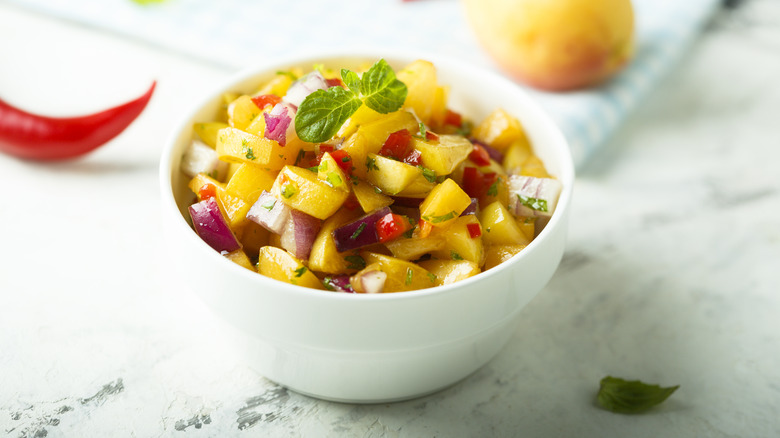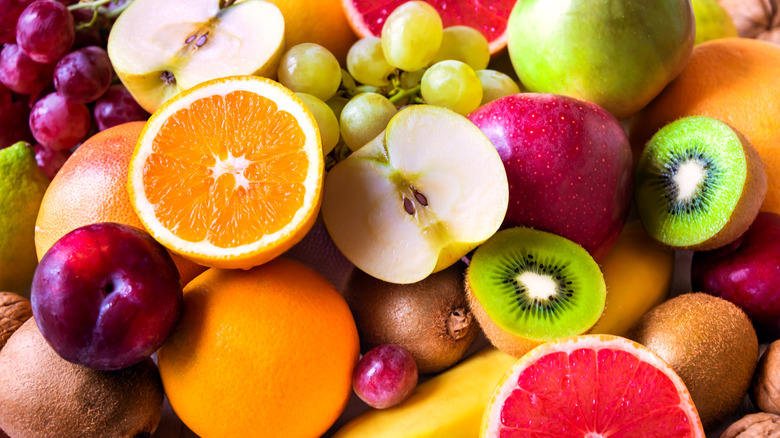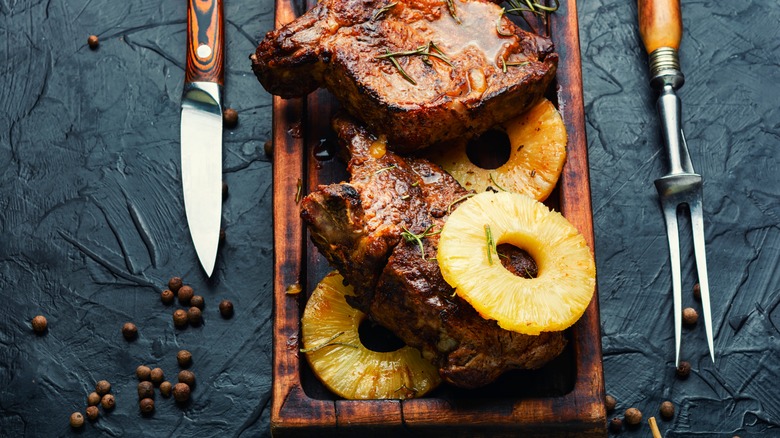Fruit Salsa Is The Steak Topping You Didn't Know You Needed
What do you serve on your steak? Maybe you reach for your favorite brand of brown sauce, or you let a dab of herb-laden compound butter melt into the beef as it rests. Here's another idea: Consider topping your steak with a sweet fruit salsa. As with many savory dishes that are lightened by unexpected hints of sweetness — from pork chops with cherry sauce to slow-cooked beef and apple stew to pineapple pizza — a fruit salsa can bring a bright freshness and a gorgeous balance of flavors to heavy cuts of meat.
Making a fresh fruit salsa is a great opportunity to use seasonal produce, whether you're celebrating summer with stone fruit or barrelling through your fall apple supply; it also allows you to get creative by adding the herbs, spices, and additional ingredients of your choice. Pairing fruit with meat is a time-honored culinary tradition, but in case you're unfamiliar, let's dive into some details to get you started.
Sweet, acidic, and (possibly) spicy
Beef and its drippings have strong, rich flavors that are beautifully tempered by sweetness, so sweeter fruits complement and balance beef better than citrus fruits. When choosing which fruits to use for your steak-destined sweet salsa, also consider textures. Do you want a smoother salsa that you can dip your steak into like a sauce, or are you after a chunkier salsa, like a classic fresh pico de gallo? For the former, choose delicate fruits, such as berries, peaches, or even kiwi. For the latter, reach for something sturdier that can be diced up, such as mango, cherries, apricots, plums, apples, or pineapple.
Of course, it wouldn't be salsa without additional ingredients mixed in. For a balanced and colorful condiment, you might turn to the add-ins you'd find in a traditional salsa, such as chopped red or white onion and cilantro, or something mild and neutral like avocado. Add dimension with an acidic ingredient, such as fresh-squeezed lime or lemon juice, chopped citrus, or a splash of fruity vinegar, as you'll find in a classic Mexican salsa.
Finally, consider turning up the heat with chilis. Sliced serranos or jalapeño will give a mild bite, chipotles (dried red jalapeños) will lend smokiness, and bright-red Calabrian chilis will give a bit more heat and a hint of fruitiness. Alternatively, a dash of hot sauce or chili powder will work in a pinch to add punch to fruit salsa.
Choosing your ingredients
If you're feeling lost when it comes to choosing a fruit for your salsa and deciding what ingredients to pair it with, you can start by drawing inspiration from other fruit and meat dishes.
Take tacos al pastor, the Mexican street dish often served with pineapple. If you're a fan, you already know how well the tropical fruit goes with smoky, spicy flavors. To get both in one place, pair the tart fruit with chipotle chilis in your fruit salsa. You could even keep the tortilla in the picture by using your steak and salsa to make a version of fajitas.
Or, take cues from a popular iteration of Moroccan-style tagine by making a cinnamon-spiked salsa with sliced almonds and fresh (or dried and soaked) apricots. Sub in dates for even more sweetness, or opt for golden raisins for a more tart flavor. Don't know what to do with that dragonfruit you purchased on a whim? Some Chinese beef recipes call for vibrantly hued tropical fruit. Consider that a sign to use it in a mildly sweet and satisfyingly crunchy salsa to spoon over your next steak.
Test out your preferences by making a few different kinds of fruit salsa and serving them in small bowls alongside your next steak. You might never go back to brown steak sauce again.


